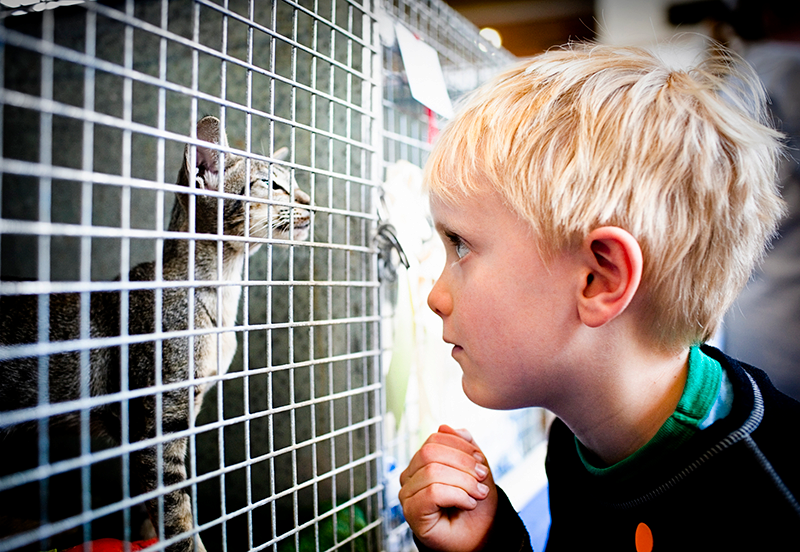Introducing a Cat to a New Pet
Are you thinking about adopting a new pet and are concerned with how your cat might respond to your new dog or cat? Cats by nature are territorial and don't usually like to share. Introducing a new cat or dog to the household might lead to some unpleasant stress-related reactions unless you approach the introduction slowly and carefully. So before you bring that new fur baby home, familiarize yourself with the best ways to help the introduction be positive.
Introducing Your Cat to a New Dog
Cats really dislike change and often need time to get used to new animals in the house. It's important to manage your expectations for how introducing a new pet will play out. We can't force our pets to like each other, but you can make the change easier to adjust to. Above all, be patient. While it's great when animals take to one another right away—and that can happen—often, it takes a few months or more for your pets to learn how to live together.1
1. Use a Calming Diffuser
Plug in a Comfort Zone Calming Diffuser a few days before introducing your cat and new dog. Your cat may display scratching or urine spraying as a result of your dog invading her turf. Comfort Zone products can help by mimicking the soothing feline facial pheromone, giving your cat a calm, relaxed feeling in any environment.
2. Give Your Cat Her Own Space and Territory
Trim your cat's claws to keep the initial interactions as safe and potentially painless for your new dog as possible. Cat trees may help your cat feel safe, as they allow your cat to get away from your new dog. Keep cat condos and scratchers around so your kitty has her own space and territory.
Don't let the dog have access to the litter box or the cat's food and water bowls. That will stress out your cat and potentially bring about territorial behavior.
3. Keep Your Cat and Dog Separated at First and Introduce Them Slowly
When bringing a new dog home, restrict him to one room with a baby gate, but don't restrict your cat. Let her have the environment she's used to. Allow the animals to sniff each other in the doorway through the baby gate at first. Reward this first interaction with treats.
When you're ready to let them know each other a little better, take your dog outside and let him run around to burn off some energy before spending time with the cat.
Sit in the living room (or other large room in the house) with the dog on a leash. Let them sniff each other, and let your cat set the pace for being comfortable. If she runs away, don't chase her or force her to spend time with the dog. If your dog starts to chase after your cat, say, "no" (or "leave it," or any other disciplinary command you use for behavior training), grab the leash, and keep him with you.
Do not scold or punish either animal during this process. You want them to associate their time together with positive reinforcement, not anger.
When you're not around, keep the animals confined in separate areas of the house. Most dogs and cats will be able to share your home in peaceful harmony, but for the first few months, it's best to keep them apart if you can't be around to supervise their interactions.
When they begin to interact in a calm, friendly manner (or even tolerate each other without any paw swipes), reward both pets with treats.
Introducing Your Cat to a New Cat
Introducing two cats needs to be done as cautiously as introducing a cat and dog. Remember, most won't take to each other right away. Forming bonds takes time and patience.2
1. Use a Calming Diffuser
To give both cats a sense of calm when they're getting to know each other, plug in a Comfort Zone Multi-Cat Calming Diffuser in your home's main living space. The diffuser will last for four weeks and helps your cat adjust to a changing environment.
2. Keep the Two Cats Separated at First
Slow introductions work best. For the first week or two, put your new kitty in a small room with her own litter box, food and water, scratching post and toys, and a bed or blankets. Close the door and don't allow the established cat to have access to that room.
Give both cats treats as they sniff each other through the door, so they associate something positive (eating) with each other's scent.
Spend equal time playing with both cats separately, so they smell each other on your clothing. Switch a blanket or other piece of bedding to help them get used to each other's smell.
After your new kitty is familiar with her feeding schedule and litter box routine, you can begin to let her have free roam of the house (when you're there to supervise) while you confine the established cat in the new cat's room. This is another way to get the cats accustomed to each other without having a face-to-face interaction—they're not ready for it yet. And it allows your new kitty to become familiar with her new home and surroundings.
3. Introduce Your Cats Slowly
After a few days of small sessions getting used to the house, you can begin familiarizing the cats with actually seeing one another. Using door stops, prop open the door to your new kitty's room ever so slightly so the cats can see each other, but don't let them play together yet. There might be sniffing, hissing, and arched backs—that's normal. You could always dangle a toy in front of them to encourage playing together. You might even use temporary screens to help them sniff each other better but still be separated.
When they've had a few days of seeing each other through the door without hissing or anger, you can begin to let them spend time together throughout the house. Try the first introduction when they're calmer, such as after a meal or a big playtime.
If either animal seems stressed, throw a soft object like a pillow near them (but not at them) and clap your hands or make another loud noise to distract and redirect their attention. If the behavior continues, separate them for 24 hours and begin the introduction process again. Over time, your cats will begin to accept each other.
4. Give Your Cats Plenty of Territory To Call Their Own
After you let them hang out in the same rooms (during the introduction process), make sure each cat has plenty of territory to call her own. This could be a cat tree, a cat condo, window perches, or cat beds. Just make sure each animal has her own "territory" to help her feel confident. You also want to make sure you have plenty of litter boxes, so they don't have to share. They might also do better to have their food and water bowls separate from each other.
Introducing your beloved cat to a new pet takes time. Cats don't like change, so you need patience and lots of understanding during the transition. But over time, your cat will adjust, and you'll be one big, happy family.
1. Animal Humane Society. "How to Introduce a Dog and Cat." AnimalHumaneSociety.org, https://www.animalhumanesociety.org/behavior/how-introduce-dog-and-cat.
2. Paws. "Introducing Your Cat to a New Cat." Paws.org, https://www.paws.org/resources/introducing-cat-to-cat/.




